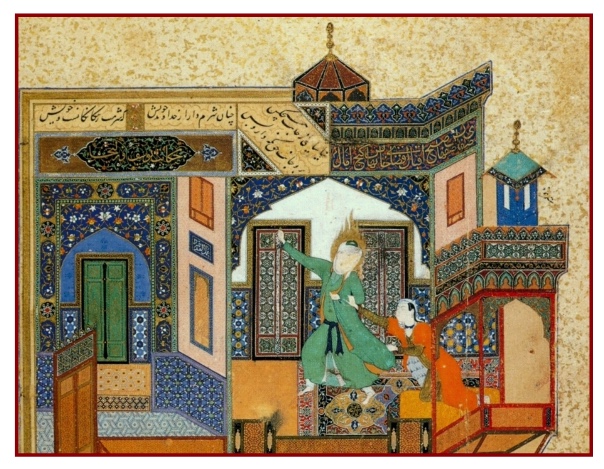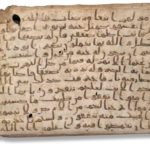
Muḥammad Masīḥ, Mālik Muslimānī and other researchers have compared the manuscripts of the Qur’ān with the manuscripts of the Old Testament (Torah). They note that the history of the Bible is characterized by a scarcity of manuscripts, but at the same time by the existence of highly specialised calligraphers and copyists demonstrating high levels of professionalism, something which could ensure high degrees of accuracy.
BY NAFI SHABOU
AS FOR THE NEW TESTAMENT, it was not written down in the era of Christ (the Gospel of Mark was written about 20 years after Christ) nor by elite specialists and professionals, but was written down through the efforts of individuals working on their own initiative and relying in this case on an abundance of manuscripts, albeit at a weaker level. This meant double the effort exerted to achieve a simpler task.
The ancient manuscripts of the Qur’ān, on the other hand, can be counted virtually on the fingers of a few hands (about 20 manuscripts). This is why, for one and the same Qur’ānic passage, there are different readings. We have 14 readings for the text, and there are other readings termed ‘abnormal’ and these rise to 980 readings, although some put this at 1000. Such a huge amount of alternative readings cannot be the result of a proper scholarly process.
Muḥammad Masīḥ adds the following points:
1 – The claimed complete text in the manuscript of Al-Mashhad al-Ḥusaynī is only partially complete;
2 – There is a Top Kapı manuscript, written in Kufic script and therefore late in date (after ‘Abd al-Malik ibn Marwān). But there is no Qur’ān in Hijazi script dating from the period of the Rightly-Guided Caliphs), only parts of the Qur’ān. These are written in a script that is undotted and unvocalised, so that one word can be read 29 times according to the which vowels and dots are assumed for it. This major obstacle stems from the nature of Arabic letters, and because the Arabic language was ‘Arab’ in the sense of dialects which trace their origin to Aramaic (Syriac) dialects. Arabic calligraphy itself evolved from the Nabataean script. Thus we have a Hijazi script and a later Kufic script.
On this Mālik Muslimānī adds that
the earliest copies of the Qur’ān were therefore not written according to any scientific standards, since these did not exist until now, and they were not written by a professional class skilled even in the process of copying.
Muḥammad Masīḥ supports what Mālik Muslimānī said and adds that
the maximum level of expertise for Zayd ibn Thābit was that as the compiler of the Qur’ān he had studied in Jewish schools exclusively in Hebrew, and that the Prophet had asked him to learn Syriac in 15 days in order to become fluent in the language! The question here is: How can a scribe write down the Qur’ān (a sacred text) all by himself when his knowledge of Syriac is still so rudimentary?
One word can be read 29 times according to the which vowels and dots are assumed for it.
As for the writers of the Old Testament (Torah), these were professional people with an accurate sense of evaluation and who knew, for example, what word should be in a specific line. They were also highly specialized (they even swore to remain conscientious in their writing, performed their ablution and prayers and then went on to write without changing a single letter in the book). The error rate was almost non-existent. And whenever they discovered a mistake, they burned what they wrote.
Whereas, in the manuscripts of the Qur’ānic text that have been discovered we see rubbings out and writings over the top of earlier writings, and even changes made later to the Qur’ānic text (as shown in the Ṣan‘ā’ manuscript, for example). There is a hadith related from Aisha, the wife of the Prophet that runs: “This is what the writer wrote while he was nodding”. It was also narrated that when ‘Uthmān ibn ‘Affān was presented with the Qur’ān and was asked to ‘correct some mistakes’, he said, “Leave it as it is, for it is not permitting anything forbidden, or forbidding anything permitted”.[i]
All the stories of the Qur’ān are incomplete reproductions from the Torah
Since the 19th century researchers have asked questions about the stories contained in the Qur’ān. Why are the majority of these stories vague and impossible to understand, especially when read for the first time? Why does the Qur’ān not give any details in its stories – names, dates and places – especially since it has quoted most of them from the Torah. This would indicate that its readers had to have prior knowledge of these stories.
The discovery of the Christian roots of the Qur’ān has provided researchers with a shining answer to these questions. In what way is this so, and why?
Unlike the stories of the Qur’ān, the stories of the Torah and the Bible are detailed, highly precise and provide realistic descriptions, because they contain all the elements of the storytelling: the names of people, places and dates, and accurate narrative structure on the model of introduction – development – conclusion.
The stories of the Qur’ān, on the other hand, are obscure and incomprehensible. Most of these stories are vague and cut up into disjointed parts scattered here and there over the Qur’ān. They are without any literary structure because they lack any introduction, any details or any conclusion [with the exception of one sūra: the Sūrat Yūsuf]. This makes the stories of the Qur’ān opaque and impossible for anyone to understand. Researchers have noted that all the stories of the Qur’ān are incomplete reproductions from the Torah, and are too obscure and incomprehensible without referring back to their origin in the Torah – with the exception of some Arabic myths such as the story of Shu‘ayb – Ṣāliḥ. The stories of the prophets in the Qur’ān are all reproduced from the Torah in a truncated form that is incomprehensible without a prior knowledge of them.
The Sūrat al-Baqara and Sūrat al-Nisā’ were considered to be works separate from the rest of the Qur’ān
Although Muslim jurists claim that the Qur’ān came to complete and correct the Torah and the ‘distorted’ Bible, they nevertheless used to refer back to the Torah in order to understand its stories, often drawing freely from Jewish mythology in the Talmud. In his work Meadows of Gold the jurist Al-Mas‘ūdī coined a strange technical term: Isrā’īliyyāt (‘Judaisms’) and throughout the history of Islam, jurists employed this term as a tool of opprobrium to marginalize, insult, declare as infidel and even proscribe their opponents.
The Qur’ān does not resemble the Torah and the Bible. The Bible (the Torah and Gospels) emerged and gradually developed over a period of more than 1,000 years, whereas the texts of the Qur’ān appeared in historical documents over a period of less than 100 years (approximately between 600-700 AD). Furthermore, it remained unknown and uncirculated until the beginning of the ‘Abbasid era.
The current Qur’ān is a single muṣḥaf and it should be noted that there are non-Islamic historical documents that testify that at the beginning of Islam around 700 AD (78 AH) the Sūrat al-Baqara and Sūrat al-Nisā’ were considered to be works separate from the rest of the Qur’ān. These jurists wrote many books under the title The Stories of the Prophets and were all quoted, sometimes verbatim, from the stories of the Torah and the Talmud, because they found nothing in the Qur’ān about these.
You cannot find in the Qur’ān a single page where the ideas and sequence of events are connected
The Bible contains dozens of stories and tales, all detailed in a near-cinematic narrative detail that enables the reader to easily understand the story, its significance and its sermonising purpose. They feature names of people and of places and the date, introductions to the tale, the course of the events and a conclusion. Whereas the Qur’ān is devoid of dates, names and places (with some exceptions such Quraysh and ‘Ād). Muslim commentators were forced to use Jewish and Christian books to interpret many Qur’ānic texts.
Muḥammad Ḥassān al-Munīr, the author of The Day before the Death of Muḥammad, observes that:
you cannot find in the Qur’ān a single page where the ideas and sequence of events are connected; some of them tumble over each other and given that the text seems unconcerned with following a narrative or highlighting some point of wisdom it needs to be extended somewhat. Once it is done with one theme it jumps into another subject wholly unconnected with it.

Suggested Reading
That is, the Qur’ān does not refer in its texts to an event or an integrated story with interconnected ideas or a historical sequence enabling the reader can follow the stages of development of the Qur’ānic text. An indication of this is that the reader who wants to follow the story of Ibrahim, for example, if he is seeking for a beginning, a theme and a conclusion for the story he will not find one, even if he reads the entire Qur’ān. Nor will he get any date for the occurrence of the events of this story, nor any chronological sequence, nor any mention of places except rarely. The reader will end up dizzy because the Qur’ānic texts about Ibrahim, just to take one example of many, are scattered over the Qur’ānic sūras, as are the stories of Moses or Jesus and others. As soon as the reader comes across a verse about Ibrahim, the text jumps to another time and another story that has nothing to do with the story of Ibrahim. All of which distracts and confuses the reader due to this absence of any historical context for the tale, a story that is supposed to have an introduction, a theme and a conclusion.
[i] See The Qur’ān, Study and Analysis, episode 122: ‘The Manuscripts and Phases in the Development of the Qur’ān.’
Main image: An Islamic version of the Biblical story of Joseph in Egypt. Potiphar’s wife (‘Zulaykha’) pursuing Yūsuf (Joseph) in a Persian miniature from Herat by Behzād, 1488 AD.
